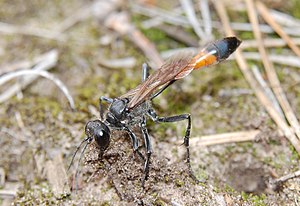Three-phase sand wasp
| Three-phase sand wasp | ||||||||||||
|---|---|---|---|---|---|---|---|---|---|---|---|---|

Three-phase sand wasp ( Ammophila pubescens ) |
||||||||||||
| Systematics | ||||||||||||
|
||||||||||||
| Scientific name | ||||||||||||
| Ammophila pubescens | ||||||||||||
| ( Curtis , 1836) |
The three-phase sand wasp ( Ammophila pubescens ) is a hymenoptera from the Sphecidae family .
features
The animals reach a body length of 15 to 19 millimeters (females) or 13 to 17 millimeters (males). The cubital cell 2 is stalked, the dorsal field is shiny between the grooves. The third tergite of the abdomen is black above, the petiolus is only sparsely hairy below. The similar sand wasp ( Ammophila campestris ) differs by a matt dorsal field, a more hairy petiolus and the third tergite is maximally slightly blackened. The females of the two species can also be clearly distinguished on the basis of their prey; those of the similar species consist of plant wasp larvae .
Occurrence
The species occurs in Central and Northern Europe. It colonizes dry habitats with sandy soils and areas with a maximum of loose vegetation. The animals fly in one generation from June to September. The species is rare in Central Europe in the south and widespread in the north.
Way of life
The females of the three-phase sand wasp look after up to three nests at the same time and also care for the brood . The nests are built three to ten centimeters deep in the sandy soil, the entrance is closed by a larger and several small stones. The brood is supplied with hairless caterpillars by tensioners . These are either brought to the nest in flight or, in the case of larger caterpillars, on foot. The caterpillar is deposited near the nest entrance, the stones are removed and the caterpillar is pulled in after a previous inspection of the nest. The wasp then lays its egg and the nest is closed again with the stones. During the development of the larva, this process is repeated twice, with a total of three to ten caterpillars being entered. Finally, the nest is finally closed with sand, the locking stones and, on top, again with sand. The caterpillar is ready to pupate after approx. 10 to 20 days. The cocoon is placed at the highest point of the nest in the direction of the entrance; overwintering takes place as a resting larva.
supporting documents
literature
- Heiko Bellmann : bees, wasps, ants. Hymenoptera of Central Europe . Franckh-Kosmos Verlags-GmbH & Co KG, Stuttgart 1995, p. 157 ff. ISBN 3-440-09690-4 .
- Rolf Witt: Wasps. Observe, determine. Naturbuch-Verlag, Augsburg 1998, ISBN 3-89440-243-1 .
Individual evidence
- ↑ a b c Heiko Bellmann : Bees, wasps, ants. Hymenoptera of Central Europe . Franckh-Kosmos Verlags-GmbH & Co KG, Stuttgart 1995, p. 157 ff., ISBN 3-440-09690-4 .
- ↑ a b c Rolf Witt: Wasps. Observe, determine. Naturbuch-Verlag, Augsburg 1998, ISBN 3-89440-243-1 .
Web links
- Ammophila pubescens in Fauna Europaea